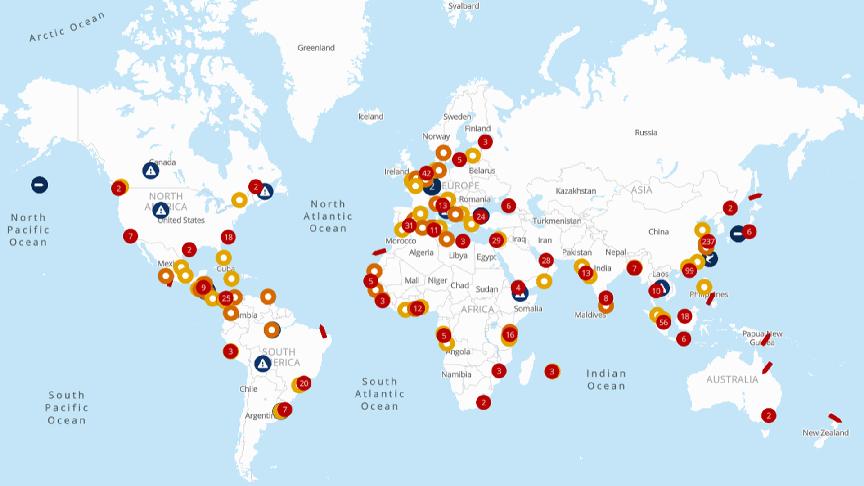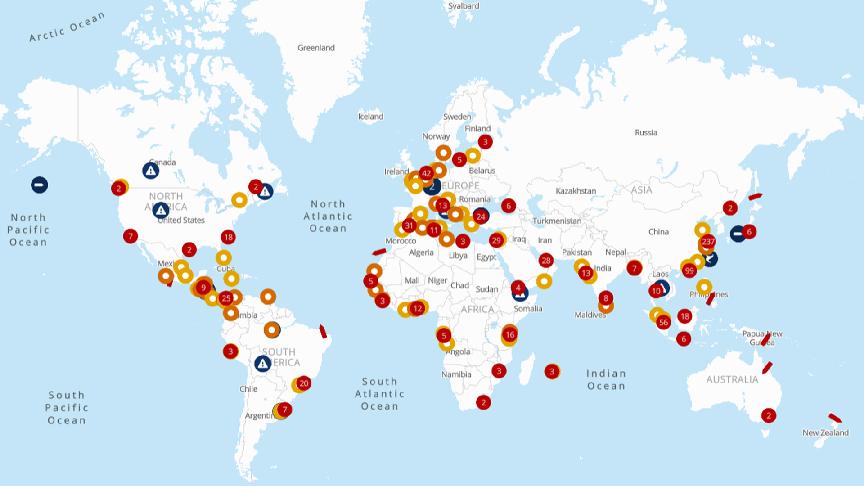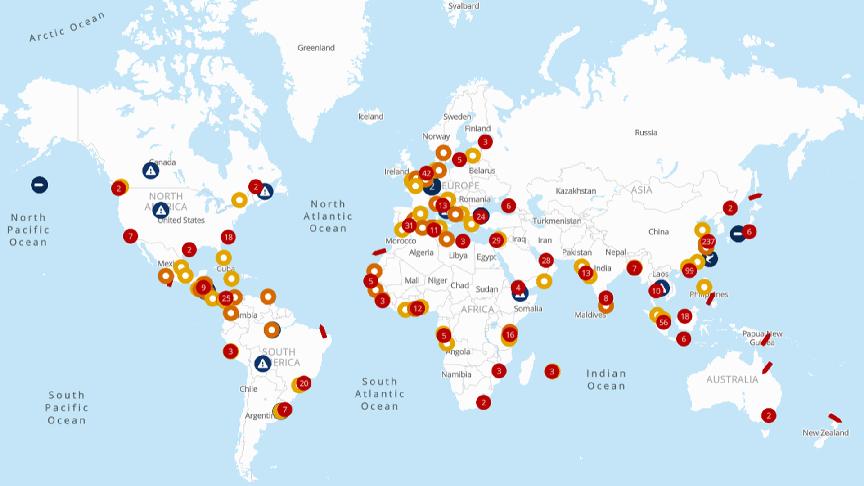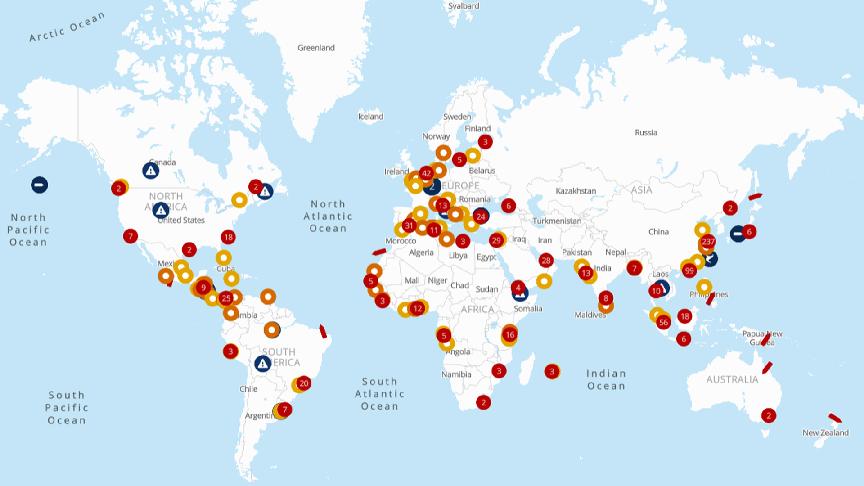- Stay ahead of supply chain disruptions and port congestion with Kuehne+Nagel’s weekly port operational update.
- Find out the latest vessel waiting times and status of ports in Africa, Asia, Oceania, Europe, the Middle East-Indian Subcontinent, North America, and South and Central America.
Africa
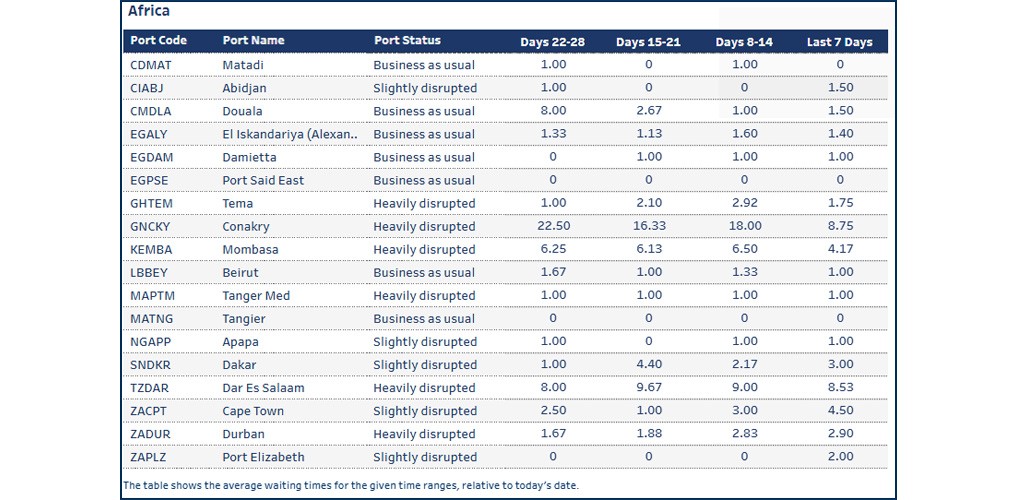
Ghana
Tema: The 7-day average vessel waiting time is around 1.75 days. The terminal is experiencing crane outages, with one crane under maintenance. Slow operations have led to vessel bunching, and ships outside their berthing windows may face delays of 8–10 days. The terminal is currently powered by generators only; therefore, operations are limited.
Guinea
Conakry: The 7-day average vessel waiting time is around 8.75 days due to heavy congestion. Some carriers even report waiting times of up to 30 days.
Guinea-Bissau
Bissau: On 26 November, Guinea-Bissau’s army seized power, ousting President Embaló and closing all borders. Bissau port operations have been fully suspended, halting maritime activities and customs clearance. No cargo movement is possible, and regional supply chains reliant on the port face severe disruption. Shippers should expect delays and rerouting until stability returns. Read more.
Kenya
Mombasa: The 7-day average vessel waiting time is around 4.17 days. Recent heavy rainfall and sporadic port disruptions have impacted vessel berthing and departure schedules, creating delays across multiple services and increasing pressure on sailing timetables and onward connections to key markets. Long-term terminal congestion, equipment shortages, and high transhipment volumes are slowing productivity, while vessel bunching and off-window arrivals are causing additional berth delays.
Mauritius
Port Louis: The 7-day average vessel waiting time is around 2.5 days due to adverse weather and operational challenges.
Morocco
Tanger Med: Southbound services are experiencing extensive delays due to heavy congestion at transhipment hubs, including Tangiers.
Maputo: Intermittent wind gusts and rainfall are expected throughout the week, which may impact operational schedules.
South Africa
Cape Town: The 7-day average vessel waiting time is around 4.5 days. Strong winds have impacted the port operations. Yard space constraints due to simultaneous handling of breakbulk and containerised cargo. Export stack dates have been inconsistent, and vessel omissions to Cape Town have occurred.
Durban: The 7-day average vessel waiting time is around 2.9 days due to recent strong winds and rain. Durban faces delays from crane replacement at Pier 2 and vessel bunching. Heavy winds and rain are expected in November. Carriers may adjust rotations or omit Durban calls to maintain schedule reliability. Additionally, rail maintenance is going on.
Port Elizabeth: The 7-day average vessel waiting time is around 2 days. Due to the citrus season, the reefer demand is high.
Asia Oceania

Indonesia
Belawan, Sumatra: Since 24 November, continuous heavy rainfall has caused severe flooding and landslides across North Sumatra. Belawan port and the surrounding business districts are heavily waterlogged, disrupting port operations and road access. Logistics and trade activities are significantly affected, with customer-side transport constrained and many delivery routes inaccessible.
On 27 November, a strong offshore earthquake (magnitude 6.5–6.6) near Simeulue Island compounded the disruption, though authorities confirm no tsunami risk. Read more.
Semarang: The 7-day average vessel waiting time is around 2.14 days.
Surabaya: The port is facing approximately 3 days of congestion in the past few weeks, and vessels arriving are not directly unloaded after berthing.
Malaysia
Kota Kinabalu: The 7-day average vessel waiting time is around 2.83 days due to severe flooding. Read more.
Port Klang: The average vessel waiting time is approximately 1.32 days due to berth congestion and vessel bunching. The yard density is around 82%.
New Zealand
Auckland: The 7-day average vessel waiting time is around 2.17 days.
Tauranga: The 7-day average vessel waiting time is around 2.67 days.
Europe

Belgium
Antwerp: The 7-day average vessel waiting time is around 1.37 days. While traffic resumed fully after the strikes that took place this week, seaexplorer shows over 10 vessels waiting outside the port with delays. Read more.
Both Q913 and Q869 yards are highly utilised (92% and 77% respectively), with reefer and empty container occupancy also high; Q913 faces minor delays of up to 11 hours, while Q869 reports no delays, and truck turnaround times range from 35–60 minutes.
PSA allows gate openings up to six days prior to the vessel’s ETA, whereas AGW permits openings five days before ETA. Gate-in schedules remain highly fluid, with carriers making last-minute changes at very short notice. Loading delays may occur as a result.
France
Le Havre: Nationwide strike announced in France against austerity. The strike will take place on 2 December and is expected to impact multiple sectors, including rail transport. Read more.
Germany
Hamburg: The 7-day average vessel waiting time is around 1.21 days. On 2 December 2025, cross-site works council meetings are planned between 12:00–15:00 and 20:00–23:00, which could result in limited handling capacity at HHLA container terminals during these periods, for EKOM on 1 December between 13:30 - 18:30.
Hamburg terminals remain under pressure: yard steady at 75%, reefers at 50%. The yard is at 100%. Construction since September reduces berth capacity; the crane maintenance has been postponed. Delays persist, though recovery plans include diversions and a shift to Unikai and CTH.
Netherlands
Rotterdam: The 7-day average vessel waiting time is around 1.09 days. Netherlands terminals stable overall:
- ECT yard at 70%, delays for barges/feeders 24–48hrs.
- MVII yard is at 95%. The terminal successfully maintained high-performance operations while operating at the upper limits of yard utilisation.
- Delta II yard low at 39%, reefers 20%, ITT challenges persist.
- RWG: Yard density reached 77% due to high import volumes and empty containers.
United Kingdom
Southampton: The yard is heavily utilised at 87% for dry and 72% for reefers, with significant congestion caused by vessel delays and prioritisation conflicts, expected to persist into next week. Planned crane rail replacement has been postponed due to delayed parts, and SCT1 will close for approximately eight days from 2 December for civil works, further exacerbating congestion, despite adequate crane gang availability.
Middle East - Indian Subcontinent
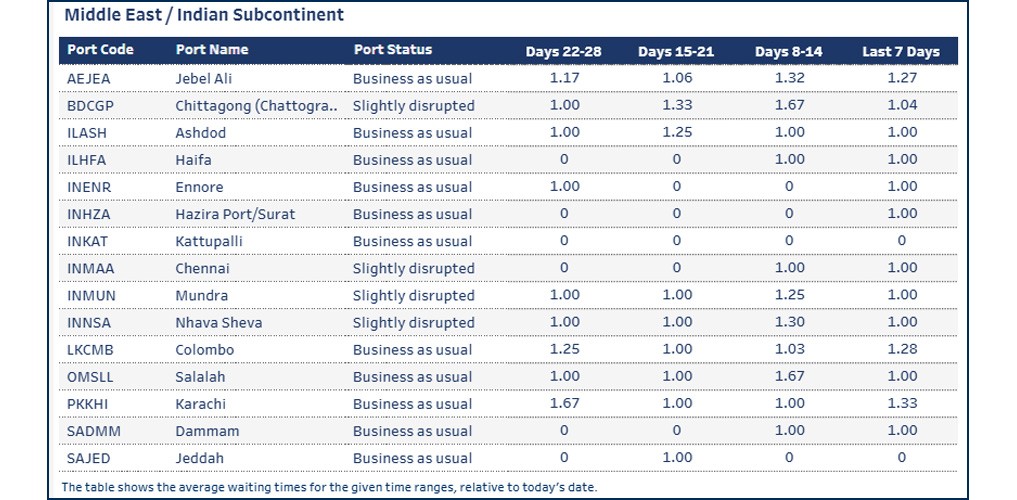 India and Sri Lanka
India and Sri Lanka
Cyclone Ditwah formed in the region this week near coastal Sri Lanka and is forecast to approach North Tamil Nadu, with a likely impact on Chennai, Ennore, Kattupalli and Karaikal ports. Read more.
North America

Canada
Average import rail dwell time for Canadian cargo (Vessel arrival to departure rail ramp):
- Halifax: 5 days
- Montreal: 6 days
- Prince Rupert: 5 days
- Saint John: 5 days
- Vancouver: 10 days
Mexico
Lazaro Cardenas: The 7-day average vessel waiting time is around 1 day. Truck import processing times improved to 48 hours. Rail platform allocation for import cargo has decreased from 8 days to 7 days.
Manzanillo: The 7-day average vessel waiting time is around 1.2 days. Operations at Manzanillo have stabilised and are running efficiently. Truck import processing times remain at 72 hours. Rail platform allocation for import cargo has increased from 5 days to 8 days.
United States
Los Angeles: A fire incident on board a container vessel, ONE Henry Hudson, prompted a temporary interruption in operations over the weekend. The port is now fully operational. Read more.
South and Central America

Chile
Iquique: The 7-day average vessel waiting time is around 3 days.
Nicaragua
Corinto: The 7-day average vessel waiting time is around 4 days. The yard density is high. Vessels can wait up to 10 days before operations begin at the port.
How Kuehne+Nagel estimates port disruption statuses
Seaexplorer has four port statuses that are estimated based mainly on the 7-day average vessel waiting time. Other factors include yard congestion, labour strikes, natural disasters or intermodal disruptions. Slightly different rules are applied to major ports, or ports that are hubs in their region, as they are typically more efficient.
- Business as usual means the port is currently operating without any significant disruption;
- Slightly disrupted is used if the 7-day average vessel waiting time exceeds 2 days;
- Heavily disrupted is used if the 7-day average vessel waiting time exceeds 4 days; and
- Port closed is used when the port suspends operations due to a major disruptive event.
How Kuehne+Nagel calculates the 7-day average vessel waiting time
Mainline container vessels may spend a certain number of days waiting at designated anchorage areas before their scheduled port call.
To calculate the 7-day average waiting time, we consider the waiting days of these vessels, excluding:
- Waiting times for feeder vessels,
- Idle ships without an announced next port,
- Slow steamers heading toward the anchorage but not actively waiting within the designated area
- Vessels passing through the anchorage area without intending to call at the port.
This rolling average is based on the data from the last seven days and is updated daily in seaexplorer.
To find the latest waiting time for a port, enter the port name or code in the search bar and select the relevant option.
Stay Ahead Stay Informed: Register for seaexplorer for the latest disruptions and vessel waiting times at global container ports.


